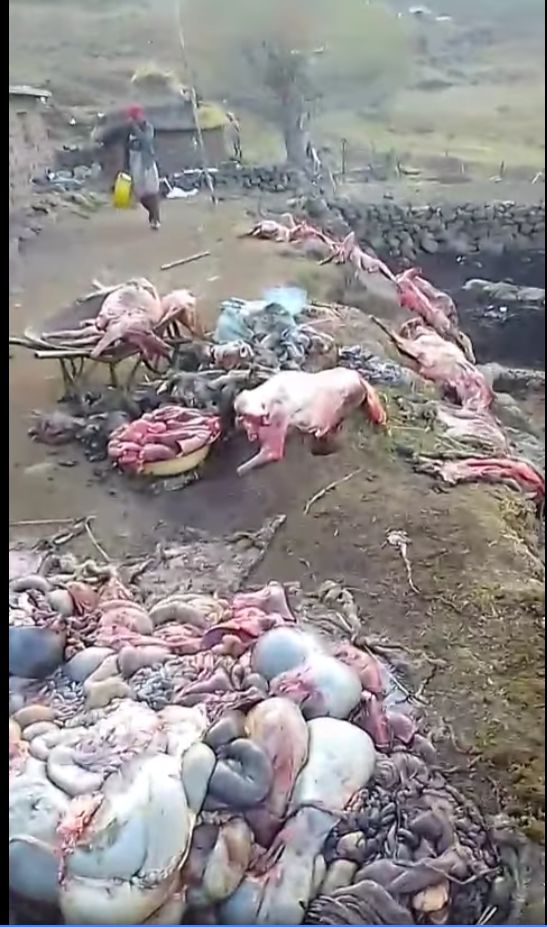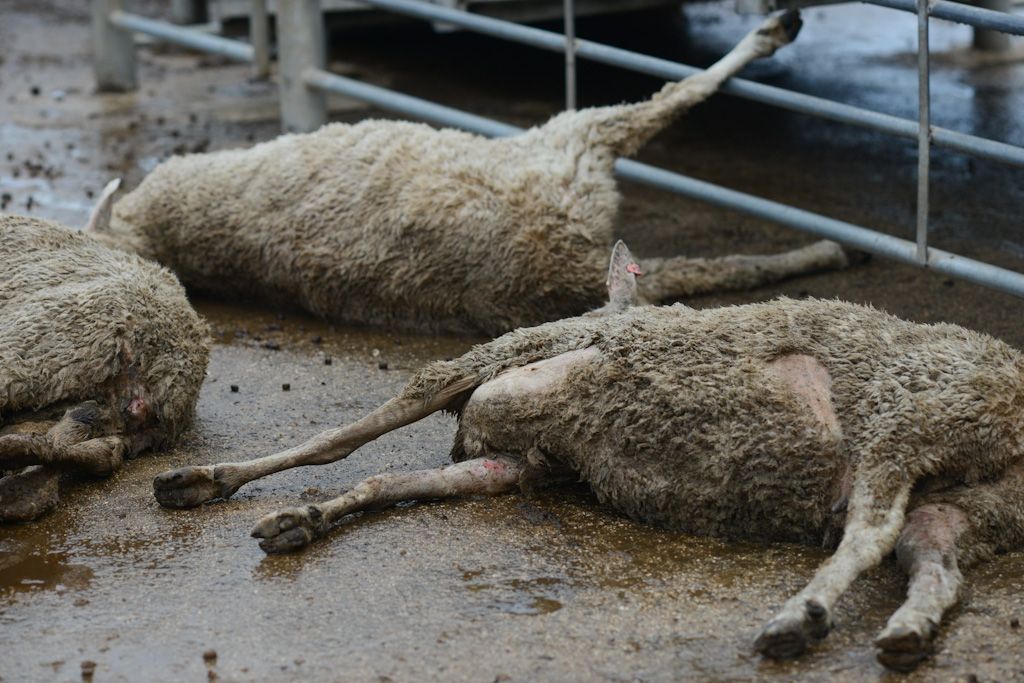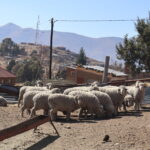Effects of Climate Change Devastates Lesotho’s Farmers
Staff Reporters
A devastating hailstorm struck the mountainous region of Thaba Putsoa, leaving behind a trail of destruction that claimed the lives of 37 sheep from Ts’olo Kou’s flock.
The incident is a sobering reminder of the harsh realities faced by farmers in Lesotho as they battle the increasingly unpredictable and severe effects of climate change.
Rethabile Kou, daughter of Ts’olo, emotionally recounted the fateful Monday afternoon.
“We had brought the sheep down for shearing, as we do every year, and only the wethers were left at the sheepfold.”
“The pregnant sheep had been home during the winter months to escape the cold, and we were in the process of transporting them back to the sheepfold in Thaba Putsoa to join the rest of the flock when the storm hit,” she shared, her voice tinged with sorrow.
As the hail came down in brutal waves, Rethabile describes that the sheep began to fall one by one, unable to withstand the harsh strokes of hail and the freezing conditions.
“After the storm, we tried to return those that survived back home with the hope of restoring the remaining life, but it was too late. Out of the 190 sheep we had, 37 died on the spot,” Rethabile explained.
She added, “Among them were 20 pregnant ewes, many of whom were carrying twins, as well as lambs that would have been ready for shearing the following year.”
For Ts’olo Kou, the tragedy is more than just a financial loss—it’s deeply personal.
“When the storm started, we tried to shelter some of the sheep under our truck, but it was futile, there was a lot of panic amongst them so much that some just couldn’t fit. They just died right in front of my eyes,” Kou said, his voice heavy with grief.
The loss of his flock, particularly the pregnant ones, amounts to more than M200,000 in potential earnings, a sum that is crucial for covering veterinary costs, shepherd wages, and other farm expenses.
“This is my livelihood. The profits I make from breeding sustain my family and my workers while the money I make from shearing can cover the farms’s operations. Losing this many sheep, especially the pregnant ones, is devastating. But I am grateful that at least this happened after shearing. I will be able to pay my herders,” Kou added, attempting to find a silver lining amid the heartbreak.
This is not the first time climate-related disasters struck Kou’s farm.
Last year, another storm killed 76 of his sheep while they were already at the sheepfold post-shearing.
Yet, Kou remains determined, “Every business has its challenges, and this is mine. I have no choice but to keep going,” he said, embodying the resilience that defines many Basotho farmers.
A Growing Crisis for Lesotho’s Farmers
The plight of Kou’s flock is not an isolated incident.
As extreme weather events become more frequent due to climate change and farmers across Lesotho are finding themselves increasingly vulnerable.
Agriculture, Food Security and Nutrition Minister Thabo Mofosi noted livestock loss happens a lot during devastating seasons.
“We urge farmers to look out for weather forecasts before engaging in any activities around their animals. There is a sense of vulnerability to animals post-shearing and they are prone to dying from extreme cold,” he said.
He added, “I only heard of two farmers so far and true. What happened is devastating, not only to them but to the agriculture sector at large.
Mofosi advised farmers to look into insuring their livestock to safeguard them from such uneventful events.
He noted that his ministry is looking into an improved climate change policy which will be inclusive of livestock farmers as well.
“It is evident that some of the health shocks we experience against animals is due to climate change. We say this year with poultry and blue tongue attacking sheep. We have seen a dire need to be intentional about our policies as a ministry,” the minister said.
The Minister of Forestry and Environment, Letsema Adonts’i, released a seasonal forecast for the period from October 2024 to March 2025 revealing an outlook predicting below-normal rainfall for most of the country, with the southwestern and extreme northern parts expected to receive normal to above-normal rains.
The forecast also warned of the increased likelihood of flash floods, thunderstorms, hailstorms, and strong winds, which could lead to widespread damage to crops and livestock.
“These severe weather events pose a significant threat to both property and the livelihoods of farmers,” Adonts’i stated, urging Basotho to prepare for the unpredictable conditions ahead.
Adapting to a Changing Climate
Lebohang Mosaola, an Agribusiness Development Specialist and Managing Director of Leseli la Lihoa, emphasised the urgent need for farmers to adapt to the changing climate.
“Due to severe droughts, farmers are losing pastureland, which in turn affects the health of their animals, leading to lower wool and mohair quality and increased susceptibility to disease and parasites,” Mosaola explained.
To combat these challenges, Mosaola advises farmers to plant drought-tolerant pasture varieties such as lucerne and kikuyu grass and practice rotational grazing to allow pastures to recover. He also recommends modern kraals with suspended floors to minimize losses during floods and provide shelter for livestock during storms.
“Winter lambing, in particular, comes with many challenges, including poor pasture quality and exposure to extreme cold. Farmers should consider adjusting their breeding schedules to align lambing with the warmer seasons when pastures are more abundant,” Mosaola added.
Weather Forecasting: A Lifeline for Farmers
Mosaola also stressed the importance of farmers staying informed about upcoming weather conditions.
“Farmers should regularly check weather forecasts from the Department of Meteorology or follow media reports before moving their animals to cattle posts. This simple practice could prevent the loss of both livestock and herders’ lives. And they need to also invest in modern kraals with shelter because things are not the same anymore,” he said.

Support and Guidance for Farmers
The Wool and Mohair Growers Association Chairperson, Mokoenihi Thinyane, shared his deep concern over the rising number of livestock deaths caused by extreme weather.
“We are still gathering data from across the districts, but the reports so far indicate that many farmers have been affected. It is heartbreaking,” Thinyane said.
To help farmers cope with these increasingly challenging conditions, the association is planning to hold a series of gatherings aimed at educating farmers on how to better protect their flocks.
“We always advise farmers to build proper sheepfolds to shelter their animals, especially after shearing when they are most vulnerable,” Thinyane mentioned.
Thinyane said some farmers are reluctant to wait out the weather with an objection that delays in acting during sudden weather changes often lead to unnecessary losses.
“We have an incident of one farmer whose sheep had already returned to the sheepfold, but they got congested in an attempt to run away from the storm that was brewing, unfortunately, many died. Timing is crucial—shepherds need to act immediately when the weather shifts,” he explained.
He highlighted that the death of pregnant sheep, in particular, represents a significant loss for both farmers and the country.
“Wool and mohair contribute greatly to Lesotho’s economy, and when we lose sheep like this, it impacts not just the farmer but the entire sector,” Thinyane pointed out.
A Regional Perspective
The effects of climate variability and change are not limited to Lesotho. At the Southern Africa Regional Climate Outlook Forum (SARCOF-29), held earlier this year, the Minister of Environment, Climate, and Wildlife, Dr. Sithembiso G. G. Nyoni, highlighted the devastating impacts of climate change on the region.
“We have witnessed first-hand the effects of extreme weather, erratic rainfall patterns, and prolonged droughts. These events threaten our ecosystems, food security, and socio-economic stability,” Dr. Nyoni stated.
Ms. Mapolao Mokoena, SADC Director of Infrastructure, emphasised the importance of seasonal forecasts in helping governments and farmers make informed decisions.
“These forecasts are crucial for sectors such as health, energy, water, and food security, particularly in light of the humanitarian appeal for US$5.5 billion made earlier this year to support over 61 million people affected by droughts and floods in the region,” Mokoena said.
As climate change continues to disrupt traditional farming practices in Lesotho, farmers like Ts’olo Kou face an uncertain future. But with the right tools, support, and adaptation strategies, Mosaola noted there is hope that Basotho farmers can rise to the challenge and continue to provide for their families and communities.
“We cannot control the weather, but we can control how we respond to it,” Thinyane said, offering a message of resilience for the farmers of Lesotho.
Summary
- The incident is a sobering reminder of the harsh realities faced by farmers in Lesotho as they battle the increasingly unpredictable and severe effects of climate change.
- “The pregnant sheep had been home during the winter months to escape the cold, and we were in the process of transporting them back to the sheepfold in Thaba Putsoa to join the rest of the flock when the storm hit,” she shared, her voice tinged with sorrow.
- As the hail came down in brutal waves, Rethabile describes that the sheep began to fall one by one, unable to withstand the harsh strokes of hail and the freezing conditions.

Your Trusted Source for News and Insights in Lesotho!
At Newsday Media, we are passionate about delivering accurate, timely, and engaging news and multimedia content to our diverse audience. Founded with the vision of revolutionizing the media landscape in Lesotho, we have grown into a leading hybrid media company that blends traditional journalism with innovative digital platforms.








